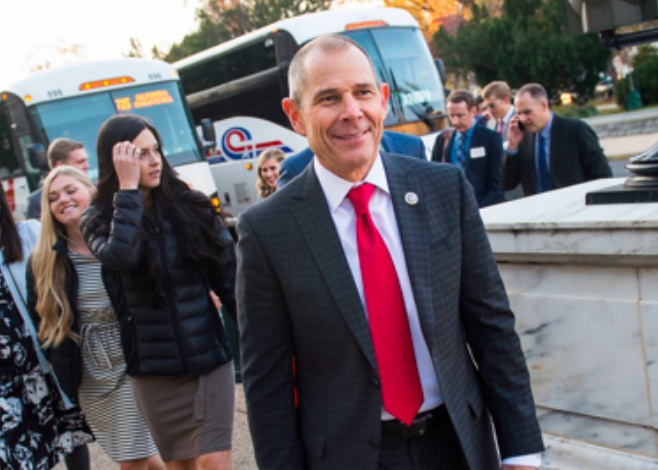A collection of more than 50 US Republican members of Congress have formed a group that aims to educate the Grand Old Party on “conservative climate solutions,” in a move that has elicited cynicism from some quarters and cautious optimism from others that America’s notoriously fossil fuel loving, climate denying party is growing up.
At a press conference in front of the Capitol in Washington on Wednesday, local time, Congressman John Curtis, who led the formation of the “Conservative Climate Caucus,” said it would be “a place for Republicans to advance serious climate solutions that do not ask them to leave their conservative values at the door”.
“Those who watch this caucus will see Republicans do care about this Earth, deeply. We, too, want to leave this Earth better than we found it. We will offer multiple solutions that in many cases are far more impactful, while enhancing economic prosperity.
“We don’t need to kill the US economy to reach our climate goals. Republicans will show the need to depart from the shaming culture found in today’s climate dialogue, and celebrate our successes.”
Curtis, who has been quietly promoting a shift towards more explicit climate policy in the Republican Party for some time said the goal of the caucus was to “bring members of the Republican Party together to educate each other on climate policies that will make real progress on reducing emissions through America and around the world.”
Rhetorically it was a far cry from the Republican former President Donald Trump, who could rarely bring himself to even mention the words climate change, instead limiting his environmental rhetoric to vacuous statements about “clean air” and “crystal clear water.”
Curtis made no actual policy suggestions, but made it very clear policies that hurt the economy or reduced jobs were unacceptable.
Aggressive moves to phase out fossil fuels also appear out of the question. On its website, the caucus explicitly states that “with innovative technologies, fossil fuels can and should be a major part of the global solution” – presumably a reference to carbon capture and storage.
After Curtis, a stream of Republicans took it in turn to present their reasoning for joining the caucus – and in so doing extinguished any illusions that Republicans had undergone a collective Damascene conversion.
It was a familiar sound to Australian ears: one by one they paid lip service to the need to tackle climate change, before going on to defend fossil fuels. In a style particularly reminiscent of Australian energy and emissions minister Angus Taylor, they quoted facts and figures out of context to make it sound like the party had done more than it actually had to address climate change.
Like Taylor, they gushed about gas and trash-talked China. China-bashing, indeed, is a central pillar of the caucus, and is embedded in one of the six principles on which the caucus is founded (see the full six at the bottom of this article).
Overall, the general gist of the press conference was, “Climate change is real and we need to reduce emissions, but…”
But what? But China is a bigger emitter than us. But we can’t make ourselves uncompetitive. But regulation stifles innovation. But we can’t let power prices go up. But we can’t allow jobs to go offshore. But gas has driven our emissions reduction to date, so let’s stop demonising it. But the world still needs coal and oil, so why stop extracting it?
More than one of them made the ridiculous claim that President Trump – an open climate denier who systematically shut down Obama-era climate policies, withdrew the US from the Paris Agreement, and once said “science doesn’t know” when challenged on his assertion that global temperatures were falling, not rising – had designed the most successful emissions reduction policies in the world.
There were a lot of buts, and very few (if any) solutions. From that perspective it sounded like a branding exercise in an era when it is now longer politically feasible to ignore climate change.
But some commentators took a different view, and saw it as a sign the ground was finally shifting. One of those was New York Times reporter Lisa Friedman, whose coverage of the announcement painted it as a fundamental if modest shift.
Curtis himself appears to be serious about shifting the party’s position on climate change and the gentle approach he is taking with this caucus could pass as politically savvy. Surely anything more aggressive would be dead on arrival, and the goal of creating a safe space for Republicans to talk about climate keeps the door open to serious change.
Could market-based reforms like carbon pricing even be on the table? It might not be as utterly unthinkable as it sounds. In an open letter signed earlier this month, 25 Republican politicians in Utah – Curtis’ home state – recently called for just that.
“We support a carbon dividends approach that puts a fee on carbon emissions and returns all the money to the American people in dividend checks,” the politicians wrote. “This approach does not require heavy-handed government oversight. The fee gives the markets an incentive to move to cleaner technologies, while the dividend protects families from the effect of higher energy prices.”
What was abundantly clear from the press conference in Washington on Wednesday, though, was that Republicans remain light years away from accepting anything like the sort of reforms implemented in the European Union – virtually the only major global jurisdiction that has managed to build a stable, non-partisan regulatory framework to address climate change. As the EU is finding, once you get serious about decarbonisation, you realise there is no way to solve the crisis without heavy regulation and spending a lot of money.
President Joe Biden’s approach, to date, has been to promise huge amounts of spending and set aggressive targets – including 50-52 per cent emissions reductions by 2030 on 2005 levels and a zero-emissions grid by 2035. But embedding those ambitions in a stable regulatory framework would require a level of cross-party consensus that simply does not yet exist in America. It is proving difficult even with the Democrats controlling the White House and both houses of Congress.
Overall, the announcement overnight sounded like a two-packs-a-day smoker with advanced emphysema conceding that it might be worth at least considering, at some point in the future (though not for a while yet), cutting back on the smokes. Unfortunately, that probably counts as progress in America.
Below are the six principles laid out on John Curtis’ Conservative Climate Caucus webpage, under the heading “What we believe”:
- The climate is changing, and decades of a global industrial era that has brought prosperity to the world has also contributed to that change.
- Private sector innovation, American resources, and R&D investment have resulted in lower emissions and affordable energy, placing the United States as the global leader in reducing emissions
- Climate change is a global issue and China is the greatest immediate obstacle to reducing world emissions. Solutions should reduce global emissions and not just be “feel good” policies
- Practical and exportable answers can be found in innovation embraced by the free market. Americans and the rest of the world want access to cheaper, reliable, and cleaner energy
- With innovative technologies, fossil fuels can and should be a major part of the global solution
- Reducing emissions is the goal, not reducing energy choices










